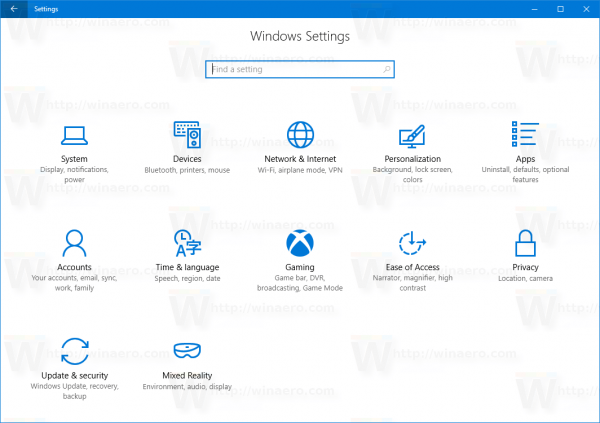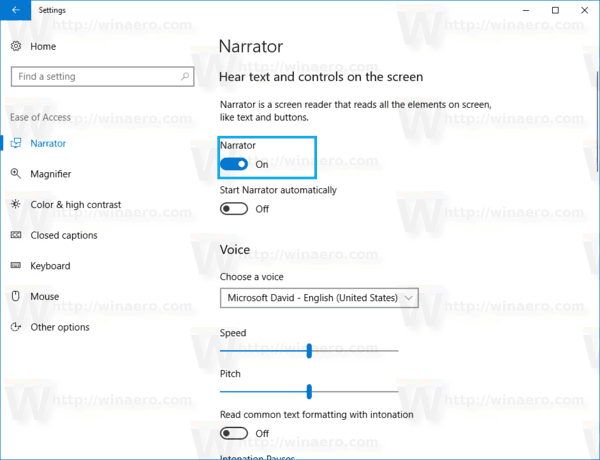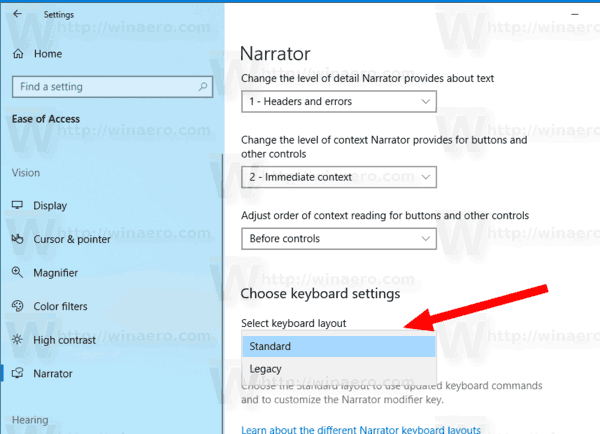Narrator is a screen-reading app built into Windows 10. Narrator lets users with vision issues to use PC and complete common tasks. It comes with two keyboard layouts: Standard and Legacy. The new Standard keyboard layout for Narrator is available starting in Windows 10 build 17692. It is designed to be more familiar to screen reader users. Here is how to change the keyboard layout for Narrator.
Advertisеment
Microsoft describes the Narrator feature as follows:
Narrator lets you use your PC without a display or mouse to complete common tasks if you’re blind or have low vision. It reads and interacts with things on the screen, like text and buttons. Use Narrator to read and write email, browse the Internet, and work with documents.
Specific commands let you navigate Windows, the web, and apps, as well as get info about the area of the PC you're in. Navigation is available using headings, links, landmarks, and more. You can read text (including punctuation) by page, paragraph, line, word, and character as well as determine characteristics like font and text color. Efficiently review tables with row and column navigation.
Narrator also has a navigation and reading mode called Scan Mode. Use it to get around Windows 10 using just the up and down arrows on your keyboard. You can also use a braille display to navigate your PC and read text.
Standard Keyboard Layout for Narrator
Here are some highlights related to the new keyboard layout for Narrator.
- Narrator now lets you use either the Caps lock or Insert keys as your Narrator modifier key.
- The Change View commands have been updated. They are now mapped to the Narrator key+Page up and Page down keys. You can also use Change View by pressing Narrator key+Ctrl+Up and Down arrow keys. Move Next and Move Previous haven’t changed.
- The Primary and Secondary Action commands in scan mode have changed. Primary Action can be executed by pressing Enter or Spacebar. You can complete Secondary Action by simply adding a Shift key to each of those keys (Shift+Enter or Shift+Spacebar). You’ll see this change regardless of the keyboard layout you select.
- Narrator’s page, paragraph, line, word, and character commands have been changed in our new Standard keyboard layout. In addition, many of Narrator’s commands have been changed to be more mnemonic. Some have also been changed to align to keystrokes that are more familiar to screen reader users.
- You can now use the numeric keypad to issue Narrator commands.
- There are a few new commands for Narrator, including List of Links, List of Headings, List of Landmarks, and Narrator Find.
- Several new scan mode keyboard commands for selecting text have been added.
- Several of Narrator’s keyboard commands for moving to Links, Headings, and Tables have been deprecated from the Standard keyboard layout. These commands are still available in scan mode and Change View.
For reference, see the following article.
To change the Narrator keyboard layout in Windows 10, do the following.
- Open the Settings app.

- Go to Ease of Access -> Narrator.

- On the right, enable Narrator.
- Now, go to the Choose keyboard settings section.
- Under Select keyboard layout, select Standard or Legacy.

Note: You will only be able to change the Narrator key if the Standard keyboard layout is enabled.
Alternatively, you can change this option with a Registry tweak.
Change Keyboard Layout for Narrator with a Registry Tweak
- Open the Registry Editor app.
- Go to the following Registry key.
HKEY_CURRENT_USER\Software\Microsoft\Narrator
See how to go to a Registry key with one click.
- On the right, modify or create a new 32-Bit DWORD value KeyboardLayout.
Note: Even if you are running 64-bit Windows you must still create a 32-bit DWORD value.
Set its value to 1 to enable the Standard (new) keyboard layout. A value data of 0 will restore the Legacy keyboard layout. - To make the changes done by the Registry tweak take effect, you need to sign out and sign in to your user account.
To save your time, you can download the following ready-to-use Registry files.
That's it.
Related articles:
- Start Narrator Before Sign-in in Windows 10
- Start Narrator after Sign-in in Windows 10
- All Ways to Enable Narrator in Windows 10
- Disable Narrator Keyboard Shortcut in Windows 10
- Hear Advanced Information About Controls with Narrator in Windows 10
- Change Narrator Keyboard Shortcuts in Windows 10
- Turn On or Off Narrator Caps Lock Warnings in Windows 10
- Read by Sentence in Narrator in Windows 10
- Disable Narrator QuickStart Guide in Windows 10
- Unlock Extra Text to Speech Voices in Windows 10
- How to Change Narrator Audio Channel in Windows 10
Support us
Winaero greatly relies on your support. You can help the site keep bringing you interesting and useful content and software by using these options:
